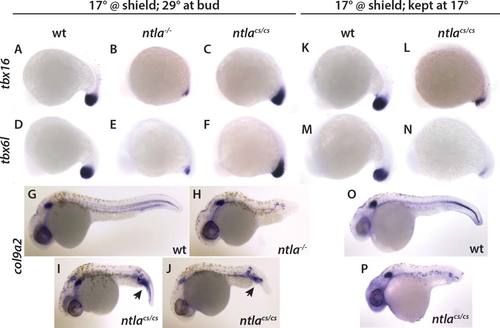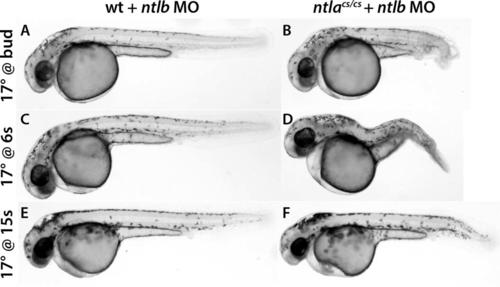- Title
-
A novel cold-sensitive mutant of ntla reveals temporal roles of Brachyury in zebrafish
- Authors
- Kimelman, D.
- Source
- Full text @ Dev. Dyn.
|
Identification of a cold-sensitive mutation in ntla. A-D: A cross from one family of fish produced embryos with a truncated tail phenotype (C, D) as well as wild-type (wt) embryos after being raised overnight at 17°C from shield stage. The phenotype is less severe than seen with the ntlab195 mutant (B, ntla-/-). E-H: Staining with the muscle antibody MF20 shows that the embryos with the truncated tails have less somitic tissue (G,H), although with less reduction than seen with ntla-/- (F). I: The mutant embryos have two base pair changes in the C-terminal domain of the Ntla coding region. The numbers indicate the base pair where the change occurred relative to the first base of the start codon. J,K: A cross of ntla-/+ and ntlacs/+ adults produced phenotypically wild-type and mutant embryos after being raised overnight at 17°C from shield stage. The genotypes of both are indicated on the figure. All embryos are shown at the equivalent of two dpf. |
|
Ntla is essential during the gastrula stages. A-E: ntlacs/cs embryos were categorized as severe, moderate, or mild. Mild embryos had either a kinked tail (E) or an essentially normal body axis with minor tail fin defects at the most posterior end (D). F: Quantification of the results from placing embryos in the cold at the indicated stages. Severe and moderate phenotypes were grouped together since embryos were a continuum between the phenotypes shown in panels B and C. G-I: Close-up images showing the posterior tail fin defects observed in the mild embryos. PHENOTYPE:
|
|
Analysis of gene expression in ntla mutant embryos. A-J: Wild-type, ntla-/-, and ntlacs/cs embryos were placed at 17°C at shield stage, then incubated at 29°C the next morning (when the embryos were at bud stage) and raised to the 14-somite stage. Whereas ntla-/- embryos had essentially no expression of the presomitic genes tbx16 and tbx6l or the notochordal gene col9a2, ntlacs/cs, embryos had strong expression of all three genes. All these embryos were hybridized with the indicated probe at the same time and for the same length of time. K-P: In contrast, when ntlacs/cs embryos were kept continuously at 17°C, expression of all three genes was considerably diminished. Arrows show accumulation of col9a2 in the posterior of ntlacs/cs embryos. EXPRESSION / LABELING:
PHENOTYPE:
|
|
Maintaining ntlacs/cs embryos at 17°C enhances the mutant phenotype. Wild-type and ntlacs/cs embryos were maintained at 17°C from shield stage until the equivalent of 2 dpf. Whereas wild-type embryos formed a normal body (although often with a curved tail), ntlacs/cs embryos appeared morphologically the same as ntla-/- embryos (see Fig. 1). PHENOTYPE:
|
|
Ntla is required for posterior development in the absence of Ntlb. Wild-type or homozygous ntlacs/cs embryos were injected with an ntlb MO and then placed at 17°C overnight at bud stage (A,B), 6-somite stage (C,D), or 15-somite stage (E,F). The embryos were then grown to the equivalent of 2 dpf at 29°C. Interfering with Ntlb function causes a truncated tail phenotype in ntlacs embryos. PHENOTYPE:
|





